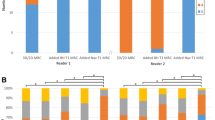Abstract
Purpose
For liver surgery, it is crucial to preoperatively examine the course of the right posterior bile duct. While MR cholangiopancreatography (MRCP) can only visualize the bile ducts, 3D balanced turbo-field-echo (BTFE) sequence clearly depicts the bile ducts and portal veins as well as drip infusion CT cholangiography (DIC-CT), without contrast media. We evaluated whether BTFE could substitute for DIC-CT.
Materials and methods
Thirty patients undergoing MRCP and BTFE on 1.5-T MR and DIC-CT were evaluated. Two readers retrospectively evaluated the branching pattern (supra-type: A–C or infra-type: D–E) and scored the degree of confidence and motion artifacts using a 3-point scale for the three 2-mm-thick reconstructed images.
Results
The bile duct diameter did not differ between DIC-CT and MRCP (p = 0.07). Five patients (17%) had intrahepatic biliary dilatation (>3 mm). The A, B, C, D, and E types were diagnosed in 21, 6, 1, 1, and 1 patient, respectively (28 supra-types and 2 infra-types) on DIC-CT. For DIC-CT, MRCP, and BTFE, the mean motion artifact scores were 3.0/3.0, 2.7/2.6, and 2.9/2.8, respectively. The mean diagnostic confidence scores were 2.9/2.9, 2.4/2.4, and 2.9/2.8, respectively, with no difference between DIC-CT and BTFE. The concordance between DIC-CT and BTFE was high (infra- or supra-type: κ = 1.00/1.00, A–E: κ = 0.86/0.66), but it was poor between DIC-CT and MRCP (infra- or supra-type: κ = 0.35/−0.05, A–E: κ = 0.33/0.41) for both readers.
Conclusions
Similar to DIC-CT, the BTFE MR sequence had high diagnostic accuracy regarding the branching pattern of the intrahepatic bile duct, especially for the supra/infraportal type.



Similar content being viewed by others
References
Kitami M, Takase K, Murakami G, et al. (2006) Types and frequencies of biliary tract variations associated with a major portal venous anomaly: analysis with multi-detector row CT cholangiography. Radiology 238(1):156–166. doi:10.1148/radiol.2381041783
Hyodo T, Kumano S, Kushihata F, et al. (2012) CT and MR cholangiography: advantages and pitfalls in perioperative evaluation of biliary tree. Br J Radiol 85(1015):887–896. doi:10.1259/bjr/21209407
Ohkubo M, Nagino M, Kamiya J, et al. (2004) Surgical anatomy of the bile ducts at the hepatic hilum as applied to living donor liver transplantation. Ann Surg 239(1):82–86. doi:10.1097/01.sla.0000102934.93029.89
Ito T, Kiuchi T, Egawa H, et al. (2003) Surgery-related morbidity in living donors of right-lobe liver graft: lessons from the first 200 cases. Transplantation 76(1):158–163. doi:10.1097/01.TP.0000072372.42396.47
Takeishi K, Shirabe K, Yoshida Y, et al. (2015) Correlation between portal vein anatomy and bile duct variation in 407 living liver donors. Am J Transplant 15(1):155–160. doi:10.1111/ajt.12965
Itatani R, Namimoto T, Takaoka H, et al. (2015) Clinical impact of 3-dimensional balanced turbo-field-echo magnetic resonance cholangiopancreatography at 3 T: prospective intraindividual comparison with 3-dimensional turbo-spin-echo magnetic resonance cholangiopancreatography. J Comput Assist Tomogr 39(1):19–24. doi:10.1097/RCT.0000000000000163
McSweeney SE, Kim TK, Jang HJ, Khalili K (2012) Biliary anatomy in potential right hepatic lobe living donor liver transplantation (LDLT): the utility of CT cholangiography in the setting of inconclusive MRCP. Eur J Radiol 81(1):6–12. doi:10.1016/j.ejrad.2010.10.013
Kitamura H, Mori T, Arai M, et al. (1999) Caudal left hepatic duct in relation to the umbilical portion of the portal vein. Hepatogastroenterology 46(28):2511–2514
Schroeder T, Radtke A, Kuehl H, et al. (2006) Evaluation of living liver donors with an all-inclusive 3D multi-detector row CT protocol. Radiology 238(3):900–910. doi:10.1148/radiol.2382050133
Kitami M, Murakami G, Ko S, et al. (2004) Spiegel’s lobe bile ducts often drain into the right hepatic duct or its branches: study using drip-infusion cholangiography-computed tomography in 179 consecutive patients. World J Surg 28(10):1001–1006. doi:10.1007/s00268-004-7483-4
Persson A, Dahlstrom N, Smedby O, Brismar TB (2006) Three-dimensional drip infusion CT cholangiography in patients with suspected obstructive biliary disease: a retrospective analysis of feasibility and adverse reaction to contrast material. BMC Med Imaging 6:1. doi:10.1186/1471-2342-6-1
Ichikawa T, Tsukamoto T, Kitamura T, Amemiya R, Okamoto E, Miyazaki K, Araki T (2002) MR cholangiopancreatoangiographic (MRCPA) images with balanced turbo field-echo (balanced TFE) sequence: a comparison with single-shot fast spin-echo sequence. Proc Intl Soc Mag Reson Med 10
Glockner JF, Lee CU (2014) Balanced steady state-free precession (b-SSFP) imaging for MRCP: techniques and applications. Abdom Imaging 39(6):1309–1322. doi:10.1007/s00261-014-0153-6
Yoon JH, Lee JM, Yu MH, et al. (2014) High-resolution T1-weighted gradient echo imaging for liver MRI using parallel imaging at high-acceleration factors. Abdom Imaging 39(4):711–721. doi:10.1007/s00261-014-0099-8
Tang Y, Yamashita Y, Arakawa A, et al. (2000) Pancreaticobiliary ductal system: value of half-Fourier rapid acquisition with relaxation enhancement MR cholangiopancreatography for postoperative evaluation. Radiology 215(1):81–88. doi:10.1148/radiology.215.1.r00ap0281
Goncalves SI, Ziech ML, Lamerichs R, Stoker J, Nederveen AJ (2012) Optimization of alternating TR-SSFP for fat-suppression in abdominal images at 3T. Magn Reson Med 67(3):595–600. doi:10.1002/mrm.23215
Bernstein MA, Huston J 3rd, Ward HA (2006) Imaging artifacts at 3.0T. J Magn Reson Imaging 24(4):735–746. doi:10.1002/jmri.20698
Glockner JF, Saranathan M, Bayram E, Lee CU (2013) Breath-held MR cholangiopancreatography (MRCP) using a 3D Dixon fat-water separated balanced steady state free precession sequence. Magn Reson Imaging 31(8):1263–1270. doi:10.1016/j.mri.2013.06.008
Author information
Authors and Affiliations
Corresponding author
Ethics declarations
Funding
No funding was received for this study.
Conflict of interest
The authors have no conflicts of interest to disclose.
Ethical approval
All procedures performed in studies involving human participants were in accordance with the ethical standards of the institutional and/or national research committee and with the 1964 Helsinki declaration and its later amendments or comparable ethical standards. For this type of study formal consent is not required.
Informed consent
Statement of informed consent was not applicable since the manuscript does not contain any patient data.
Rights and permissions
About this article
Cite this article
Ogawa, M., Ozawa, Y., Ohta, K. et al. Usefulness of 3D balanced turbo-field-echo MR sequence evaluating the branching pattern of the intrahepatic bile ducts: comparison with drip infusion CT cholangiography. Abdom Radiol 42, 1888–1895 (2017). https://doi.org/10.1007/s00261-017-1093-8
Published:
Issue Date:
DOI: https://doi.org/10.1007/s00261-017-1093-8




